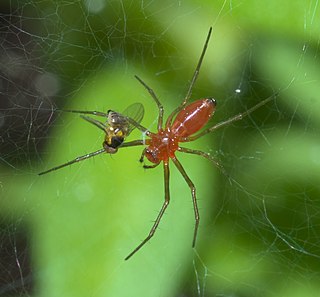
The blacktailed red sheetweaver, also known as red grass spider, is a species of dwarf spider. It is the only species in the monotypic genus Florinda. It was first described by Octavius Pickard-Cambridge in 1896, and has only been found in Mexico, the West Indies, and the United States. It is common in the southeastern United States, inhabiting grasslands, lawns, and agricultural fields.
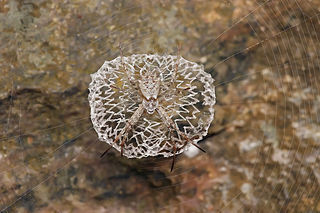
A stabilimentum, also known as a web decoration, is a conspicuous silk structure included in the webs of some species of orb-web spider. Its function is a subject of debate.

Micrathena, known as spiny orbweavers, is a genus of orb-weaver spiders first described by Carl Jakob Sundevall in 1833. Micrathena contains more than a hundred species, most of them Neotropical woodland-dwelling species. The name is derived from the Greek "micro", meaning "small", and the goddess Athena.

Stemmops is a genus of comb-footed spiders that was first described by Octavius Pickard-Cambridge in 1894.
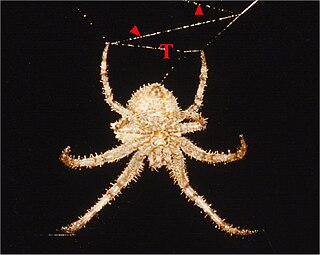
Kaira, sometimes called frilled orbweavers, is a mostly neotropical genus of orb-weaver spiders first described by O. Pickard-Cambridge in 1889. It includes sixteen described species that occur from South America up to the southern and eastern USA. It is presumably related to Aculepeira, Amazonepeira and Metepeira.

Acacesia is a genus of orb-weaver spiders first described by Eugène Simon in 1895. It contains six species with a mostly neotropical distribution, ranging from South America to Mexico. One species, A. hamata, is found in the US as well.
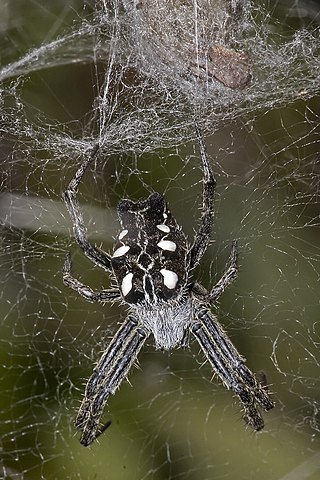
Cyrtophora citricola, also known as the tropical tent-web spider, is an orb-weaver spider in the family Araneidae. It is found in Asia, Africa, Australia, Costa Rica, Hispaniola, Colombia, and Southern Europe and in 2000, it was discovered in Florida. C. citricola differs from many of its close relatives due its ability to live in a wide variety of environments. In North America and South America, the spider has caused extensive damage to agricultural operations.

Cyrtophora exanthematica are tent spiders common in tropical Asia and Australia. They are commonly known as double-tailed tent spiders because of the pair of blunt projections at the end of their abdomens. They are harmless to humans.

Neoscona oaxacensis, known as western spotted orbweaver and zig-zag spider, is a species of spider in the family Araneidae. It is distributed in the Americas, from Kansas and California south to Venezuela and Peru, including the Galápagos Islands.
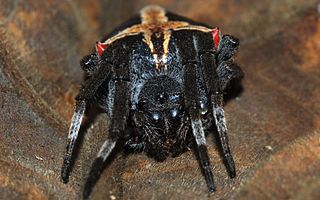
Parawixia is a genus of orb-weaver spiders first described by F. O. Pickard-Cambridge in 1904. Most species are found in the Neotropics but one species, Parawixia dehaani, is found in Australasia and tropical Asia as far west as India.
Pickardinella is a monotypic genus of Mexican long-jawed orb-weavers containing the single species, Pickardinella setigera. The species was first described by Frederick Octavius Pickard-Cambridge under the name Leucauge setigera, and was moved to its own genus in 1951. Physically, they resemble members of Opadometa and Leucauge. Males are very small, only growing up to about 2 millimetres (0.079 in) long. A female has never been found.
Edricus is a genus of orb-weaver spiders first described by O. Pickard-Cambridge in 1890. As of April 2019 it contains only two species.
Kapogea is a genus of orb-weaver spiders first described by Herbert Walter Levi in 1997.
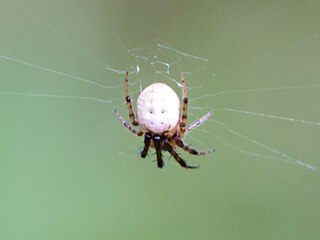
Metazygia is a genus of orb-weaver spiders first described by F. O. Pickard-Cambridge in 1904. They physically resemble members of Nuctenea, but they do not have fine setae on the carapace.

Wagneriana is a genus of orb-weaver spiders first described by F. O. Pickard-Cambridge in 1904.
Epeirotypus is a genus of ray spiders that was first described by Octavius Pickard-Cambridge in 1894.
Epilineutes is a monotypic genus of South and Central American ray spiders containing the single species, Epilineutes globosus. The genus was first described by Jonathan A. Coddington in 1986. The single species was first described in 1896 under the name Andasta globosa, but has also been referred to as Theridiosoma globosum.
Melpomene elegans is a species of spider in the family Agelenidae. It is found in Mexico.

Wamba is a genus of comb-footed spiders that was first described by Octavius Pickard-Cambridge in 1896. As of September 2019 it contains three species, found in the Americas, including the Caribbean: W. congener, W. crispulus, and W. panamensis.

Salsa fuliginata, commonly known as the sooty orbweaver, is a orb-weaver spider of Araneidae in the genus Salsa. The species is found throughout southeastern Australia and New Zealand.














